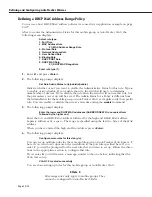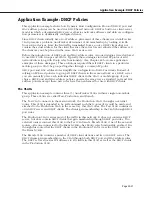
Defining and Configuring AutoTracker Policies
Page 20-15
Defining a Port Binding Policy
Port binding polices require devices to match two or three criteria. The criteria can be one of
six combinations:
1.
The device can attach to a specific switch port
and
use a specific MAC address
and
use a
specific protocol (IP or IPX).
2.
The device can attach to a specific switch port
and
use a specific MAC address
and
use a
specific IP network address
3.
The device can attach to a specific switch port and use a specific protocol (IP or IPX)
4.
The device can use a specific IP address
and
use a specific MAC address
5.
The device can use a specific port
and
a specific IP address
6.
The device can use a specific port
and
a specific MAC address.
A device must match all values in the criteria set.
Port binding policies have two additional features. First, if a policy violation is detected, an
SNMP trap is generated to alert the network manager which rule was violated. Secondly, if
you attempt to configure a port binding rule that creates a conflict with another binding rule,
an error message is generated to alert the user of the problem.
For example, if a port binding rule is created with a policy that links IP address 1.1.1.1 and
MAC address aabbcc:ddeeff, and you attempt to create a port binding rule for the same IP
address with a policy that links it to port 3/1, an error message will appear as shown:
This IP address has already been assigned to a different rule
In this example the second port binding rule is not created because the purpose of the first
rule is to provide mobility for the IP address 1.1.1.1 (i.e., it is not restricted to a port), while
the second rule specifically limits the mobility of IP address 1.1.1.1 to port 3/1.
A general rule for port binding policies is that once an address has been assigned (MAC or
IP), it cannot be assigned to another policy until it is removed from the first policy. The
following table is a reference for policy conflicts:
Limitations for Port Policies
IP Address
MAC Address
Port
Protocol
IP Address
N/A
IP and MAC address
cannot be used again
IP address cannot be
used again
N/A
MAC Address
IP and MAC address
cannot be used again
N/A
MAC address cannot
be used again
MAC address cannot
be used again
Port
IP address cannot be
used again
MAC address cannot
be used again
N/A
None
Protocol
N/A
MAC address cannot
be used again
None
N/A
Summary of Contents for Omni Switch/Router
Page 1: ...Part No 060166 10 Rev C March 2005 Omni Switch Router User Manual Release 4 5 www alcatel com ...
Page 4: ...page iv ...
Page 110: ...WAN Modules Page 3 40 ...
Page 156: ...UI Table Filtering Using Search and Filter Commands Page 4 46 ...
Page 164: ...Using ZMODEM Page 5 8 ...
Page 186: ...Displaying and Setting the Swap State Page 6 22 ...
Page 202: ...Creating a New File System Page 7 16 ...
Page 270: ...Displaying Secure Access Entries in the MPM Log Page 10 14 ...
Page 430: ...OmniChannel Page 15 16 ...
Page 496: ...Configuring Source Route to Transparent Bridging Page 17 48 ...
Page 542: ...Dissimilar LAN Switching Capabilities Page 18 46 ...
Page 646: ...Application Example DHCP Policies Page 20 30 ...
Page 660: ...GMAP Page 21 14 ...
Page 710: ...Viewing the Virtual Interface of Multicast VLANs Page 23 16 ...
Page 722: ...Application Example 5 Page 24 12 ...
Page 788: ...Viewing UDP Relay Statistics Page 26 24 ...
Page 872: ...The WAN Port Software Menu Page 28 46 ...
Page 960: ...Deleting a PPP Entity Page 30 22 ...
Page 978: ...Displaying Link Status Page 31 18 ...
Page 988: ...Displaying ISDN Configuration Entry Status Page 32 10 ...
Page 1024: ...Backup Services Commands Page 34 14 ...
Page 1062: ...Diagnostic Test Cable Schematics Page 36 24 ...
Page 1072: ...Configuring a Switch with an MPX Page A 10 ...
Page 1086: ...Page B 14 ...
Page 1100: ...Page I 14 Index ...
















































